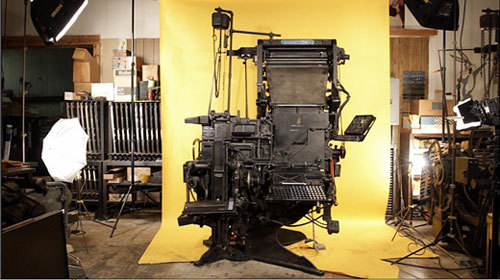You’d imagine filmmakers would want their lead characters to be complex, layered — nuanced, even.
Given that criteria, maybe the Linotype machine is not such a strange film subject as it appears to be at first glance.
The Linotype, after all, revolutionized the printing of newspapers and magazines beginning in the late 1800s. It’s complex all right — a massive hulk of metal pieces that enabled printers, for the first time, to produce an entire line of type at one time instead of letter-to-letter typesetting. Hence the name, “a line o’ type.”
And while the machine was just a mechanical breakthrough, it led to a communication-based society that is still evolving today. You might even say that smart phones and Facebook are cousins (in spirit, anyway) to the clunky old Linotype.
It was all these layers that convinced filmmaker Doug Wilson and his collaborators to make “Linotype: The Film — In Search of the Eighth Wonder of the World.”
The documentary comes to Portland next week, at Space on Congress Street. Wilson, the film’s director and producer, says he wanted to make the film to introduce the world to this intriguing and world-changing character.
“I wanted to make the film because I felt the story of the Linotype and the people who love and operated them has never been told. I found it fascinating that, for a machine that had such a huge impact on the world, the Linotype had long been forgotten,” said Wilson from Chicago, where he was traveling to promote the film.
“The Linotype is a crazy Rube-Goldbergian device that is amazing to see in action,” he said. “We all know about Henry Ford and Thomas Edison, but no one knows about Ottmar Mergenthaler and his invention that impacted printing and communications.”
The Linotype was replaced in the 1960s and ’70s, first by offset lithography printing and then by computer typesetting. But the machine is still appreciated today by former operators, mechanical buffs and people who appreciate the art and science of printing.
One of those is Mark Jamra, an associate professor of graphic design at Maine College of Art and a digital type designer who owns a Portland-based company called TypeCulture. His company is one of the sponsors of the Linotype film at Space.
“I’ve been designing digital typefaces for close to 30 years, and the Linotype is a prominent figure in the history of type,” said Jamra. “The Linotype is such a fascinating machine to watch in action — its complexity boggles the mind. It’s an industrial era-type foundry and composing room compressed into a single machine.”
The film not only tells the history of the machine, it helps people see the connection between it and the creation of a more fluid, responsive mass media to all the communications technologies we now find in our pockets.
“Without the Linotype, we would not have the communications systems that we have today,” said Wilson. “The Linotype allowed for the daily newspaper instead of just a weekly newspaper. This shift to day-old or even just hour-old news was a massive change from the week-old news of before.
“Today, we essentially have a Linotype in our pocket — our smart phones that are constantly updating our news and information.”
Staff Writer Ray Routhier can be contacted at 791-6454 or at:
rrouthier@pressherald.com
Twitter: Ray Routhier
Send questions/comments to the editors.



